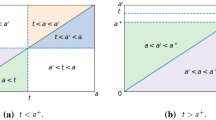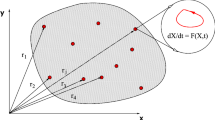Abstract
In this paper, we consider a system of nonlinear delay integro-differential equations with convolution kernels, which arises in biology. This problem characterizes the population dynamics for two separate species. We present an exponential approach based on exponential polynomials for solving this system. This technique reduces the model problem to a matrix equation, which corresponds to a system of nonlinear algebraic equations. Also, illustrative examples related to biological species living together are given to demonstrate the validity and applicability of technique. The comparisons are made with the existing results.



Similar content being viewed by others
Explore related subjects
Discover the latest articles, news and stories from top researchers in related subjects.References
Kot M (2001) Elements of mathematical ecology. Cambridge University Press, Cambridge
Pougaza D-B (2007) The Lotka integral equation as a stable population model. Postgraduate Essay, African Institute for Mathematical Sciences (AIMS), Muizenberg
Kopeikin ID, Shishkin VP (1984) Integral form of the general solution of equations of steady-state thermoelasticity. J Appl Math Mech (PMM U.S.S.R.) 48(1):117–119
Lotka AJ (1939) On an integral equation in population analysis. Ann Math Stat 10:144–161
Abdul J (1999) Introduction to integral equations with applications. Wiley, New York
Khan Y, Va´zquez-Leal H, Wu Q (2013) An efficient iterated method for mathematical biology model. Neural Comput Appl 23:677–682
Dehghan M, Shakeri F (2008) Solution of an integro-differential equation arising in oscillating magnetic fields using He’s homotopy perturbation method. Progr Electromag Res 78:361–376
Khan Y, Taghipour R, Falahian M, Nikkar A (2013) A new approach to modified regularized long wave equation. Neural Comput Appl 23:1335–1341
Elmer CE, Van Vleck ES (2002) A variant of Newton’s method for solution of traveling wave solutions of bistable differential-difference equation. J Dyn Differ Equ 14:493–517
Elmer CE, van Vleck ES (2001) Travelling wave solutions for bistable differential-difference equations with periodic diffusion. SIAM J Appl Math 61:1648–1679
Khan Y (2013) A method for solving nonlinear time dependent drainage model. Neural Comput Appl 23:411–415
Babolian E, Biazar J (2002) Solving the problem of biological species living together by Adomian decomposition method. Appl Math Comput 129:339–343
Shakeri F, Dehghan M (2008) Solution of a model describing biological species living together using the variational iteration method. Math Comput Model 48:685–699
Yousefi SA (2011) Numerical solution of a model describing biological species living together by using Legendre multiwavelet method. Int J Non Sci 11(1):109–113
Shakourifar M, Dehghan M (2008) On the numerical solution of nonlinear systems of Volterra integro-differential equations with delay arguments. Computing 82:241–260
Adomian G (1990) A review of the decomposition method and some recent results for nonlinear equations. Math Comput Model 13(7):17–43
Batiha B, Noorani MSM, Hashim I (2007) Variational iteration method for solving multispecies LotkaVolterra equations. Comput Math Appl 54:903–909
Parand K, Razzaghi M (2004) Rational Chebyshev tau method for solving Volterra’s population model. Appl Math Comput 149:893–900
Yüzbaşı Ş (2012) Bessel collocation approach for solving continuous population models for single and interacting species. Appl Math Model 36(8):3787–3802
Sedaghat S, Ordokhani Y, Dehghan M (2014) On spectral method for Volterra functional integro-differential equations of neutral type. Numer Funct Anal Optim 35:223–239
Yüzbaşı Ş (2012) A numerical approach to solve the model for HIV infection of CD4+T cells. Appl Math Model 36(12):5876–5890
Pamuk S (2005) The decomposition method for continuous population models for single and interacting species. Appl Math Comput 163:79–88
Dehghan M, Salehi R (2010) Solution of a nonlinear time-delay model in biology via semi-analytical approaches. Comput Phys Commun 181:1255–1265
Pamuk S, Pamuk N (2010) He’s homotopy perturbation method for continuous population models for single and interacting species. Comput Math Appl 59:612–621
Yüzbaşı Ş (2011) A numerical approach for solving a class of the nonlinear Lane-Emden type equations arising in astrophysics. Math Method Appl Sci 34(18):2218–2230
Dehghan M, Shakeri F (2010) Solution of parabolic integro-differential equations arising in heat conduction in materials with memory via He’s variational iteration technique. Int J Numer Method Biomed Eng 26:705–715
Merdan M (2007) Homotopy perturbation method for solving a model for HIV infection of CD4+T cells, Istanb. Commer Univ J Sci 12:39–52
Shakeri F, Dehghan M (2011) The finite volume spectral element method to solve turing models in the biological pattern formation. Comput Math Appl 62:4322–4336
Yüzbaşı Ş (2013) A numerical approximation for Volterra’s population growth model with fractional order. Appl Math Model 37(5):3216–3227
Khan Y, Vázquez-Leal H, Faraz N (2013) An auxiliary parameter method using Adomian polynomials and Laplace transformation for nonlinear differential equations. Appl Math Model 37:2702–2708
Khan Y (2014) A novel Laplace decomposition method for non-linear stretching sheet problem in the presence of MHD and slip condition. Int J Numer Methods Heat Fluid Flow 24:73–85
Akyüz-Daşcıoğlu A, Sezer M (2005) Chebyshev polynomial solutions of systems of higher-order linear Fredholm-Volterra integro-differential equations. J Franklin Inst 342:688–701
Yüzbaşı Ş, Şahin N, Sezer M (2011) Numerical solutions of systems of linear Fredholm integro-differential equations with Bessel polynomial bases. Comput Math Appl 61(10):3079–3096
Khan Y, Sayevand K, Fardi M, Ghasemi M (2014) A novel computing multi-parametric homotopy approach for system of linear and nonlinear Fredholm integral equation. Appl Math Comput 249:229–236
Yüzbaşı Ş, Sezer M (2013) An exponential matrix method for solving systems of linear differential equations. Math Method Appl Sci 36(3):336–348
Alharbi F (2010) Predefined exponential basis set for half-bounded multi domain spectral method. Appl Math 1:146–152
Alipour MM, Domairry G, Davodi AG (2011) An application of exp-function method to approximate general and explicit solutions for nonlinear Schrodinger equations. Numer Method Part Differ Eqs 27:1016–1025
Shanmugam R (1998) Generalized exponential and logarithmic polynomials with statistical applications. Int J Math Educ Sci Technol 19(5):659–669
Xu M, Chen L, Zeng Z, Li ZB (2010) Reachability analysis of rational eigenvalue linear systems. Int J Syst Sci 41(12):1411–1419
Ouerdiane H, Ounaies M (2012) Expansion in series of exponential polynomials of mean-priodic functions. Complex Var Elliptic Eqs 57(5):469–487
Debrecen LS (2000) On the extension of exponential polynomials. Math Bohem 125(3):365–370
Ross K (1963) Abstract harmonic analysis I, II. Springer, Berlin
Acknowledgments
The first author is supported by the Scientific Research Project Administration of Akdeniz University. We would like to thank all of the referees separately for their constructive comments and suggestions to improve the paper.
Author information
Authors and Affiliations
Corresponding author
Rights and permissions
About this article
Cite this article
Yüzbaşı, Ş., Sezer, M. An exponential approach for the system of nonlinear delay integro-differential equations describing biological species living together. Neural Comput & Applic 27, 769–779 (2016). https://doi.org/10.1007/s00521-015-1895-y
Received:
Accepted:
Published:
Issue Date:
DOI: https://doi.org/10.1007/s00521-015-1895-y




